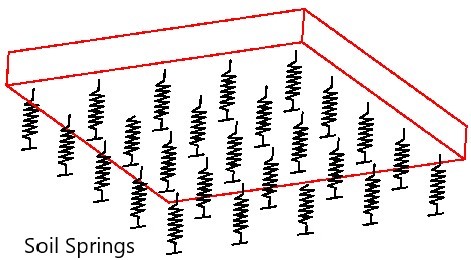The design of rock anchors is done to anchor structure to rock. Structures are anchored into the rock to maintain its stability or carrying the loading on the structural elements such as walls, foundations, etc. Different types of forces acting on the structures are transferred as tensile force or comprehensive force or shear forces.
Depending on the method of stress transfer, the design of the anchors is carried out. The design of the anchors to transfer the tensile forces are elaborated in this post. Three main factors are considered in the design.
- Permissible bond stress between the steel and the grout
- Permissible bond stress between grout and rock
- Check for dislodging of rock mass
For example, consider the design of the tank for uplift.
The following equations are used in the design of rock anchors.
Actual force in each anchor = Unbalanced uplift pressure / No of anchors required per unit area .. 01
Depth of anchor bars in rock mass = Actual force in each anchor / ( π x d1 x F1)..02
Depth of anchor bars in rock mass = Actual force in each anchor / ( π x d2 x F2)..03
Check for tensile failure of the steel
Where
F1 – Permissible bond stress between steel and grout
F2 – Permissible bond stress between ground and rock
d1 – Diameter of the anchoring bar
d2 – Diameter of the anchor hole
F1 and F2 can be vary based on the condition at the site. However, conservative values could be obtained from related books.
Basic Steps are as follows in Design of Rock Anchors
Calculate the unbalance uplift force act on the anchors. This could be calculated by deducting the weight of the structure from the uplift force.
Select a sustainable bar diameter. This could be done bars on the experience of trial and error procedure could be followed.
Calculate the permissible tensile stress of the reinforcements. Tensile stress could be taken as 0.87 times the yield stress of the bars (according to British code).
Calculate the force carry by the bar without tensile failure. (= 0.87x fy x are of a bar)
Calculate the number of anchors and their spacing using applied force and the capacity of the anchor.
The depth of the anchor bars could also be calculated from equation 02 and 03. Consider whichever higher.
Check for dislodging of the rock mass anchored against uplift forces. A wedge could be considered as shown in the following figure to calculate the weight of the rock mass that may be lifted due to the anchors. An angle of 22.5 degrees from anchor to sloping plane could be considered for the calculation.

![Tunnel Design [a guide to designers]](https://www.structuralguide.com/wp-content/uploads/2019/11/Tunnel-1-1024x599.jpg)
